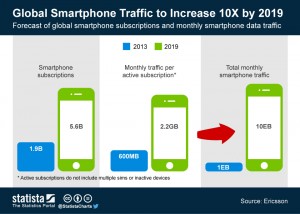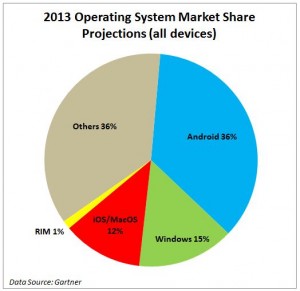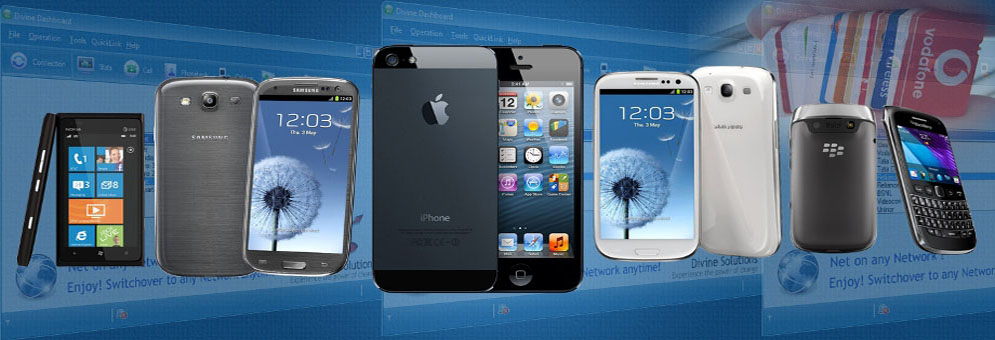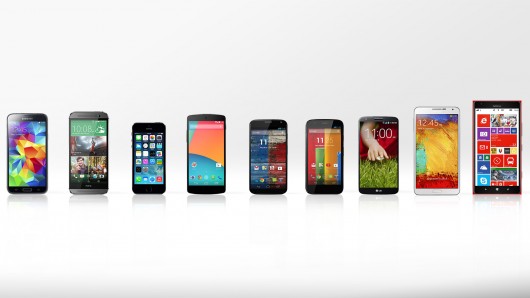The mobile phone industry has been on a meteoric rise, both in global adoption and in consumer choices in the marketplace. As a result, mobile quality assurance is quickly playing a larger role for companies that do business online. A strong case can be made that a lack of quality assurance could blindside unprepared companies as mobile growth continues to explode. It’s not hard, after all, for a consumer to simply exit your site or app and find a competitor quickly that is optimized for mobile. The evolving market is showing less and less patience for a phone or app that’s not fully mobile operable.
The Growth of Mobile Phone Usage
 The numbers show that mobile phone usage is dramatically on the rise. Mobile traffic accounts for about one-third of all web traffic, and that figure continues to increase. According to Time, mobile internet usage has a recent trend of tripling annually, as it did in 2013. By 2015, mobile data use is expected to increase by a factor of 26, a number that certainly takes into account the rising popularity of mobile apps. The seven billion or so mobile connections throughout the world continue to drive the increase in mobile data usage, a trend that draws attention to the need for quality assurance, and its more prominent role in the future of mobile business.
The numbers show that mobile phone usage is dramatically on the rise. Mobile traffic accounts for about one-third of all web traffic, and that figure continues to increase. According to Time, mobile internet usage has a recent trend of tripling annually, as it did in 2013. By 2015, mobile data use is expected to increase by a factor of 26, a number that certainly takes into account the rising popularity of mobile apps. The seven billion or so mobile connections throughout the world continue to drive the increase in mobile data usage, a trend that draws attention to the need for quality assurance, and its more prominent role in the future of mobile business.
Analyze Relevant Mobile Analytics Traffic Data
Companies should closely evaluate their mobile analytics traffic data when considering which mobile device they should QA test. New companies still in the thick of product development should closely examine trends in their industry relevant to the mobile phone market, particularly which platform offers the most and/or best apps for their industry. To find out, browse iPhone’s App Store and Google Play for Android to compare the popularity of apps in your company’s industry, weighing variables like the number of votes and downloads for the app.
If you find that your mobile analytics traffic data is similar across multiple devices, then it may be best to conduct QA testing for all or several of them. MyCrowd makes this possible via a crowdsourced group of QA testers that are specialized in most mobile devices. Internal testing can cause delays for multiple devices, as it can be hard to track device usage without a very effective management process. As a result, outsourcing should be considered in any scenario where QA testing is needed for multiple mobile devices.
Consider the Options
Unless your data shows a favorite mobile device within your company’s target demographic, choosing a mobile device for QA testing can be a daunting task. The options are varied, both in devices and operating systems. Devices like the Samsung Galaxy S5, iPhone 6, and Nexus 6 will likely be among the most talked-about phones of 2014. iOS and Android continue to lead among mobile OS, with Windows, Blackberry and (for international users) Symbian.
Since iOS is limited to only a few phone models, it’s worthwhile to consider the various new and emerging phones that use Android, which is the most rapidly rising phone OS. When deciding which Android devices to QA for, the eight below are a good place to start:
Samsung Galaxy S3 and S4 – According to data from AppBrain, Samsung Galaxy S3 and S4 remain the most-used Android phones. Although S5 is on the horizon, both the S3 and S4 remain the go-to devices for many Android users.
Samsung Galaxy Note 3 – Although its current market share (2.8%) is less than the S3 (6.6%) and S4 (5.6%), the Samsung Galaxy Note 3 has a strong and rising niche due to its sharp 5.7-inch 1080p HD screen and S-Pen stylus, a feature that has plenty of app-based potential.
Google Nexus 5 – With a trusted name in Google and a smart design, the Google Nexus 5 is a safe choice for many Android users. A lengthy battery life and top-notch multimedia features make it one of the better high-end Android options.
Motorola Moto G – Motorola’s smartphone revival starts with the Moto G handset, which has a low-end price tag ($175) despite some quality mid-end features. Most importantly, its market share is up 20% in the past month.
Sony Xperia Z2 – A trusted choice for frequent travelers, the Sony Xperia Z2 has some of the best battery life among Android devices, lasting an entire day. The phone runs on Android 4.4 with Sony’s own custom interface, which some users prefer.
LG G3 – Another high-end choice, with a 5.5-inch high-quality HD screen that makes it a suitable choice for mobile users that use multimedia on the go. This is a particularly important device to test for if your company’s demographic is multimedia-savvy, such as a video effects studio.
OnePlus One – One of the most customizable phone options since it uses a CynogenMod version of Google’s mobile OS, the OnePlus One is a buzzed-about phone that can continue to rise in popularity due to its affordable price. Despite this, its relative sparsity makes it not a very attractive option for QA testing as of now.
HTC One M8 – The first new big Android release of 2014, the HTC One M8 is worthwhile to consider for QA testing due to its sleek and industry-leading features, though it comes with a higher-end price tag that suits the features. The HTC One M8 still seems a year or so away from emerging as a leader.
Examine the Relationship Between Your Target Demographic and Mobile App Usage
 Last year, Google Play store caught up to Apple in available apps, and surpassed Apple in app downloads. Yet Apple had more app revenue. Very recent data show that Android is growing faster than iOS in the U.S. and elsewhere, but apps in the Apple store continue to see the most profit among the various mobile OS.
Last year, Google Play store caught up to Apple in available apps, and surpassed Apple in app downloads. Yet Apple had more app revenue. Very recent data show that Android is growing faster than iOS in the U.S. and elsewhere, but apps in the Apple store continue to see the most profit among the various mobile OS.
When deciding which OS to QA for, companies often find themselves weighing Android’s promising recent growth against Apple’s reliability and market share sustainability. It’s also useful for companies to refer to usage statistics via mobile analytics traffic data, particularly to find out which mobile devices are being most frequently used to access their web site. This data will provide a clearer picture of which mobile devices a business’ customers or potential customers use most.
Take All Variables Into Account Before Testing
If you want to know which mobile device you should QA test, your target demographic’s preference is not very prevalent. Examining analytical and app behavioral data, along with your company’s popularity in mobile app stores, is a good way to find out which mobile device is right for your customers. In some cases, testing several mobile devices is the best option, made even easier by the on-demand QA testing provided by MyCrowd. Once the target OS and device is identified, it’s easy to research the most popular devices in each category.
Quality assurance testing for mobile devices is not something to skimp over. Obstacles like poor mobile load times, errors, and compatibility issues can doom a company’s success with mobile users, who are becoming more common by the day.



